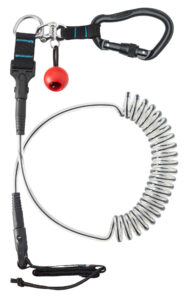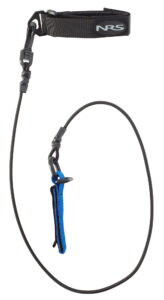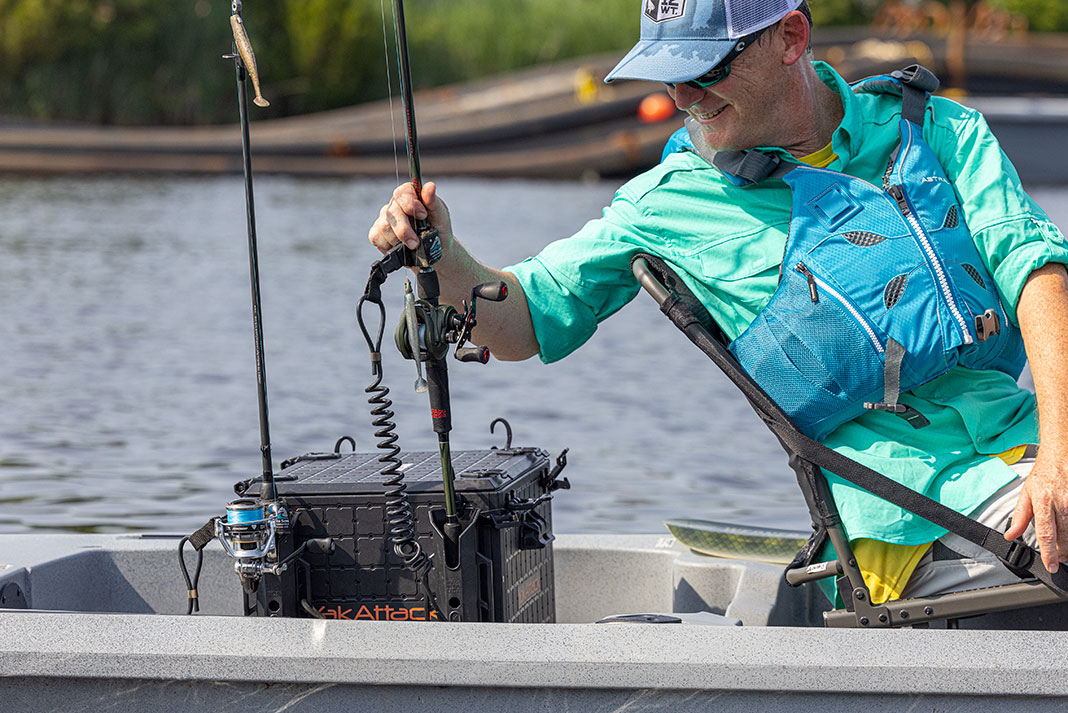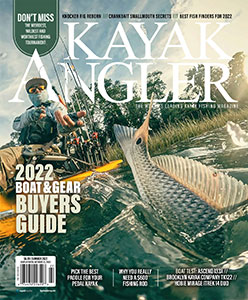Products You May Like
In less than a second, I was in the water. I was leaning to the left side of my kayak and landing a fish when the wind swept in from the right side, flipped my kayak and deposited me in the water. I surfaced, spitting and cursing, next to my inverted kayak surrounded by bobbing water bottles and a handful of floating granola bar wrappers.
Righting the kayak and reentering the boat, I collected the flotsam and took inventory of my losses. A pair of scissors, a pair of sunglasses and two lures were gone. But my paddle, fishing rods and pliers were safely tethered to my kayak. When the seas kick up and the weather turns nasty, I take a second to leash my valuables to my kayak. A little precaution can save a lot of money.
Everything You Need to Know About Leashes and Tethers
Paddle Leash
The paddle leash is one of the most abused accessories on a fishing kayak. I see newbie anglers paddling through calm water with their paddle leashed to the kayak. What’s the point?
Adding a paddle leash adds weight to the paddle and interferes with paddling. Also, if you go overboard, there is a chance of becoming entangled in the leash. Under normal circumstances, you don’t need a paddle leash.
I only use a paddle leash in extreme situations. When the wind is blowing so hard it wants to rip the paddle from my hand or off the deck, I add a leash.
Another time I use a leash is when I’m anchored in swift current. I fear if I drop the paddle in the water, it will be swept away.
To keep my paddle in the boat, I attach a paddle leash from the paddle to the kayak. My leash is a heavy-duty coiled cable. A brass clip at one end attaches the leash to a pad eye mounted on the kayak deck between my legs.

At the other end, a padded collar with double-sided velcro closure wraps around the center of my paddle shaft. I like a leash with a quick-release function so I can disengage the leash when I don’t need it. My leash is so durable, I leave it on the kayak so I have it when I need it.
Of course the best precaution against losing a paddle is to carry an extra paddle. Last spring I was caught on a huge flat in a thunderstorm. Instead of paddling through the wind and whitecaps, I decided to wade across the shallows to calmer water pulling my kayak behind me.
When I arrived at deeper water on the lea side of the flat, I discovered my paddle had been swept off my boat. I should have leashed it to the kayak. Thankfully, I had a backup paddle in my hatch.
As soon as I pulled out the reserve paddle, I leashed it to the kayak and returned directly to the launch. Nothing is worse than getting caught up a creek without a paddle, as they say.
Rod Leash
Like my paddle leash, I store three rod leashes on my kayak. My leashes are on my kayak for 100 percent of my fishing trips, but I only use them 10 percent of the time.
I use rod leashes going through the surf, paddling across choppy water and bouncing down light rapids.

My rod leashes are the same as my paddle leash: a heavy, coiled cord with a brass clip at one end and a removable collar at the other end. The detachable collar makes it easy to unclip the rod from the leash for fishing, then clip the leash back on the rod when I stick the rod in the rod holder.
I attached pad eyes next to my flush mount rod holders to leash my rods when I’m trolling, drifting or soaking baits.
Mostly, I use the rod leashes when my rods are in the vertical rod holders on my crate. I attach the brass clip to the crate and wrap the collar around the rod’s foregrip. The heavy-duty coiled cord keeps the leashes from tangling.
When I need my rod leashes, I’m glad I have them. I estimate I’ve flipped my kayak 10 times, five times my rods were saved by rod leashes. Mostly, my rod leashes offer an extra layer of security when the seas get choppy. If the kayak flips, at least I don’t have to worry about losing my fishing rods.
Gear Tether
The three things I drop overboard most often are scissors, grippers and pliers. I can’t count how many times I set down my scissors, make a cast and hear a plunk followed by a bloop. Or I land a fish, hold it up, remove the hook with the pliers. Then the fish kicks, I drop the pliers to catch my catch and both go overboard. Lip grippers seem to be destined for a burial at sea. To release a fish, I hold it in the water with a lip gripper. When the fish regains composure, I unclip the gripper and the fish swims away. That’s when I usually drop the gripper into the water.
A gear tether would save me in each example. Now, I attach my lip gripper to a 10-foot length of paracord with a brass clip at the end. I clip the line to my anchor trolly before clipping the gripper to the fish’s lip. If I drop the gripper while reviving a fish, the gripper slides down my anchor trolley.
My response to fumbling my scissors and pliers is to buy cheap scissors and pliers. If I lose them, I’m not too upset.
I carry backup tools to replace lost or malfunctioning gadgets. I recently received a pair of Simms Flyweight pliers that fit perfectly on my life vest. I like the set up when I am standup fishing and don’t want to lean over and pick up my pliers off the deck. To keep the premium pliers from escaping, I use the coiled tether attached to my life jacket.
Boat Line
The leash I use most is a 12-foot, braided cord with a clip on one end and a wrist loop on the other. Like my rod leashes and paddle leash, the boat line lives on my kayak.
I use this cord as a dock line and drag rope. To stake my kayak in shallow water, I attach the clip to my anchor trolley and loop the wrist cuff around my stakeout pole. When my wife and I paddle to our favorite riverside restaurant, we use the boat line to tie our kayaks to the dock.
The boat line really comes in handy when I have to drag my kayak through shallow water or over dry land. Attaching the line to my bow handle and putting the wrist loop over my hands, I can easily lead the boat through shallow water.
Believe it or not, it’s easier to drag the kayak a long distance with the rope than the bow handle. The boat’s flat bottom slides across grass instead of dragging the transom and digging into the ground.
The braided cord is incredibly strong, it doesn’t stretch and it is super light, perfect for stowing under my crate until I hit bottom.
Which is the key to successfully using leashes on the kayak. When seas are calm and the wind is light, there is no reason to use a leash. But when the waves kick up and the water turns frothy, I attach a leash to everything that doesn’t float.
Protect expensive fishing gear from loss with a leash. | Feature photo: Patrick “Buzz” Hayes

 This article was first published in the Summer 2022 issue of Kayak Angler Magazine.
This article was first published in the Summer 2022 issue of Kayak Angler Magazine.